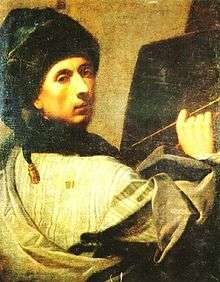Vito D'Anna
Vito D'Anna (14 October 1718 – 13 October 1769) was an Italian painter, considered the most prominent painter of Palermitan rococo and one of the most important artists of Sicily.
Vito D'Anna | |
|---|---|
 Vito D'Anna, Self portrait, 1763. | |
| Born | 14 October 1718 Palermo, Italy |
| Died | 13 October 1769 (aged 50) Palermo, Italy |
| Nationality | Italian |
| Known for | Painter |
Notable work | Apotheosis of St. Dominic Apotheosis of Palermo Allegory of Political Virtues Glory of the Princes of Resuttana Glory of St. Basil |
| Movement | Baroque, Rococo |
Biography
He was the father of Alessandro D'Anna, the brother-in-law of Francesco Sozzi, and the son-in-law of Olivio Sozzi.
He studied under Pietro Paolo Vasta from 1736 to 1744, when he returned to Palermo. In Acireale, he had painted Portrait of the Provost Gambino, (the work is found in the sacristy of the Cathedral).
In Palermo, Vito married the daughter of the Catanese painter Olivio Sozzi. Sozzi helped arrange D'Anna to work with the circle of an aged Corrado Giaquinto in Rome.
D'Anna frescoed a number of palaces, and the churches of San Sebastiano, San Matteo and del Salvatore in Palermo. Among his works were: his fresco of the Madonna dei Raccomandati in the church of the same name, his Nativity in the church della Grotta, Self-portrait in the Galleria Zelantea.[1] His nephew, Giuseppe Patania, was also a painter.
Works
- Apotheosis of St. Dominic or Gloria dei santi domenicani, 1751, frescos of the dome, church Santa Caterina, Palermo.
- The Triumph of Minerva, 1751, fresco, Palazzo Benenati Ventimiglia, Palermo.
- Allegory of Virtues, 1751, frescos, Palazzo Benenati Ventimiglia, Palermo.
- Il Trionfo dei Re Magi, 1751–52, fresco, Chiasa dei Tre Re, Palermo.
- Trinità, oil on wood, Palazzo Abatellis, Palermo.
- Apotheosis of Palermo, 1760, fresco of the ballroom, Palazzo Isnello, Palermo.
- Allegory of Political Virtues, 1762, fresco of the ballroom, Palazzo Alliata di Pietratagliata, Palermo.[2]
- Glory of the Princes of Resuttana, 1762, fresco of the ballroom, Villa Resuttana, Palermo.
- Glory of St. Basil, 1763–65, frescos, church of Santissimo Salvatore, Palermo.
Honors
- In 1762 he was elected a member of the Academy of Saint Luke
- In 1765 he was named Count palatine
- In 1765 he became a Knight of the Order of the Golden Spur
See also
References
Bibliography
- Agostino Gallo, manuscript, 19th century.
- Renato Roli, Giancarlo Sestieri. I disegni italiani del Settecento. Treviso, Canova Edizioni, 1982. ISBN 88-85066-03-8
- Dizionario biografico degli italiani, 32nd issue. Rome, Enciclopedia Italiana, 1986.[3]
- Citti Siracusano, La pittura del Settecento in Sicilia. Rome, De Luca, 1986.
- Giuliano Briganti (editor). La Pittura in Italia. Il Settecento, volume 2. Milan, Electa, 1990. ISBN 978-88-435-3279-7
- Sergio Troisi, Vito D'Anna. Palermo, «Kalos», issue 4, July/August, 1993.
- Giulia Sommariva. Palazzi nobiliari di Palermo. Palermo, Dario Flaccovio, 2004. ISBN 88-7758-598-6
- Mariny Guttilla. Mirabile artificio. Pittura religiosa in Sicilia dal XV al XIX secolo. Palermo, Kalos, 2006. ISBN 88-89224-27-4
- Mariny Guttilla (editor). Cantieri decorativi a Palermo dal tardo barocco alle soglie del neoclassicismo, in Il Settecento e il suo doppio.[4] Palermo, Kalós, 2008, p. 177–206. ISBN 978-88-89224-67-0
Notes
- Galleria Zelantea, notes on arts in Acireale.
- Storia di Palazzo Alliata di Pietratagliata Archived 5 November 2010 at the Wayback Machine. Retrieved 1 September 2010.
- M. G. Paolini. Vito D'Anna – Biography at the Enciclopedia Italiana. Retrieved 1 September 2010.
- Il Settecento e il suo doppio. Table of contents. Central Institute for restoration and preservation of books – OPAC. Retrieved 1 September 2010.
External links
| Wikimedia Commons has media related to Vito D'Anna. |
- (in Italian) Vito D'Anna. Biographical Archive of Palermo.